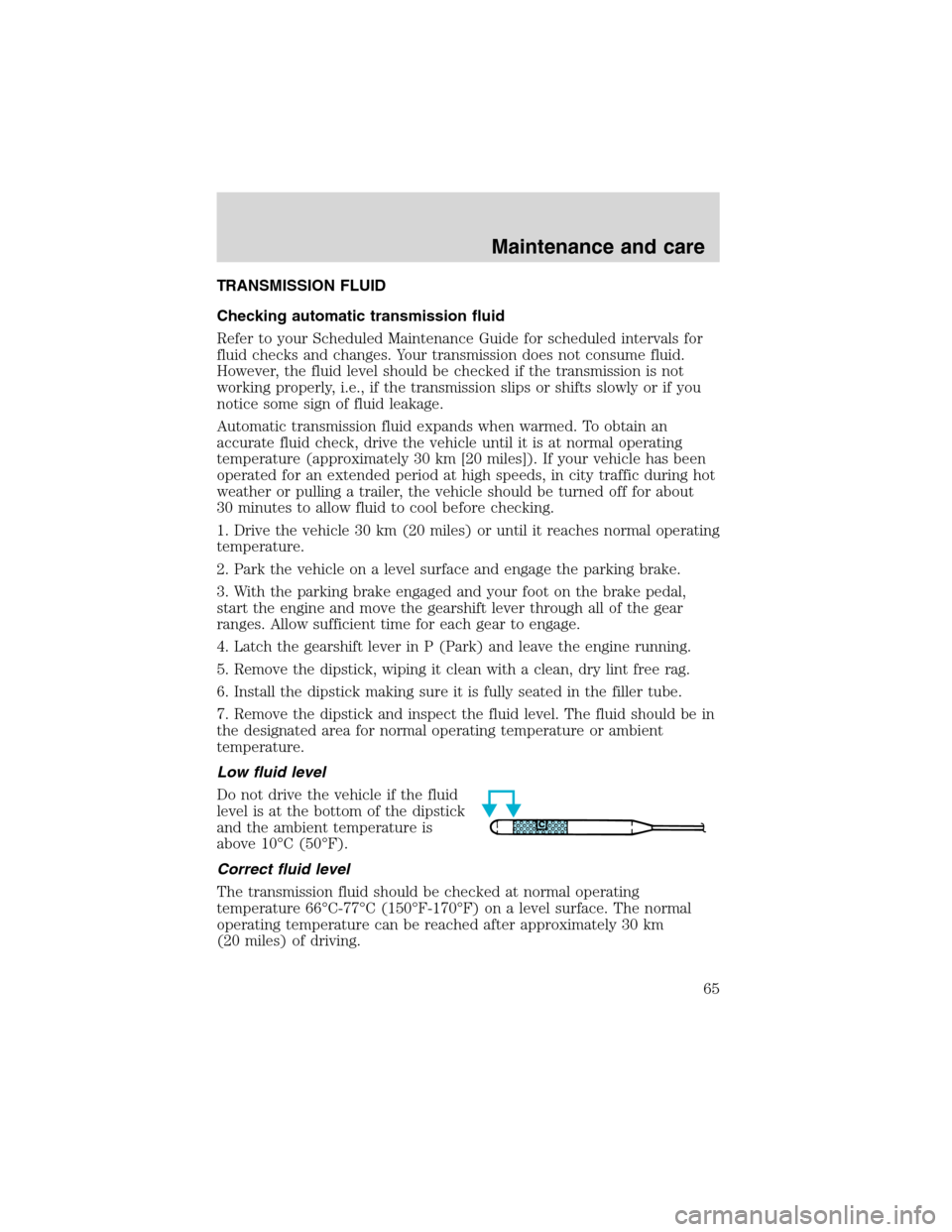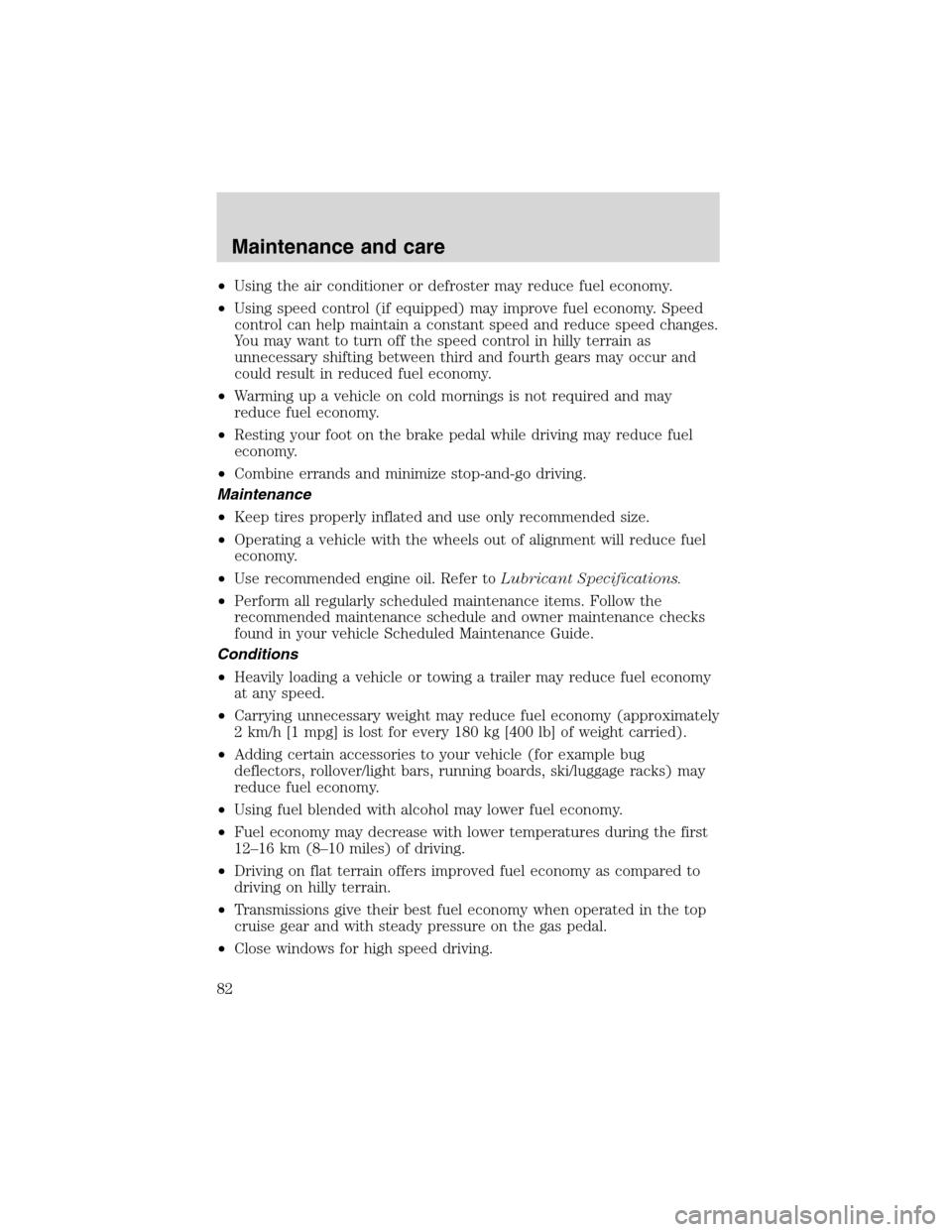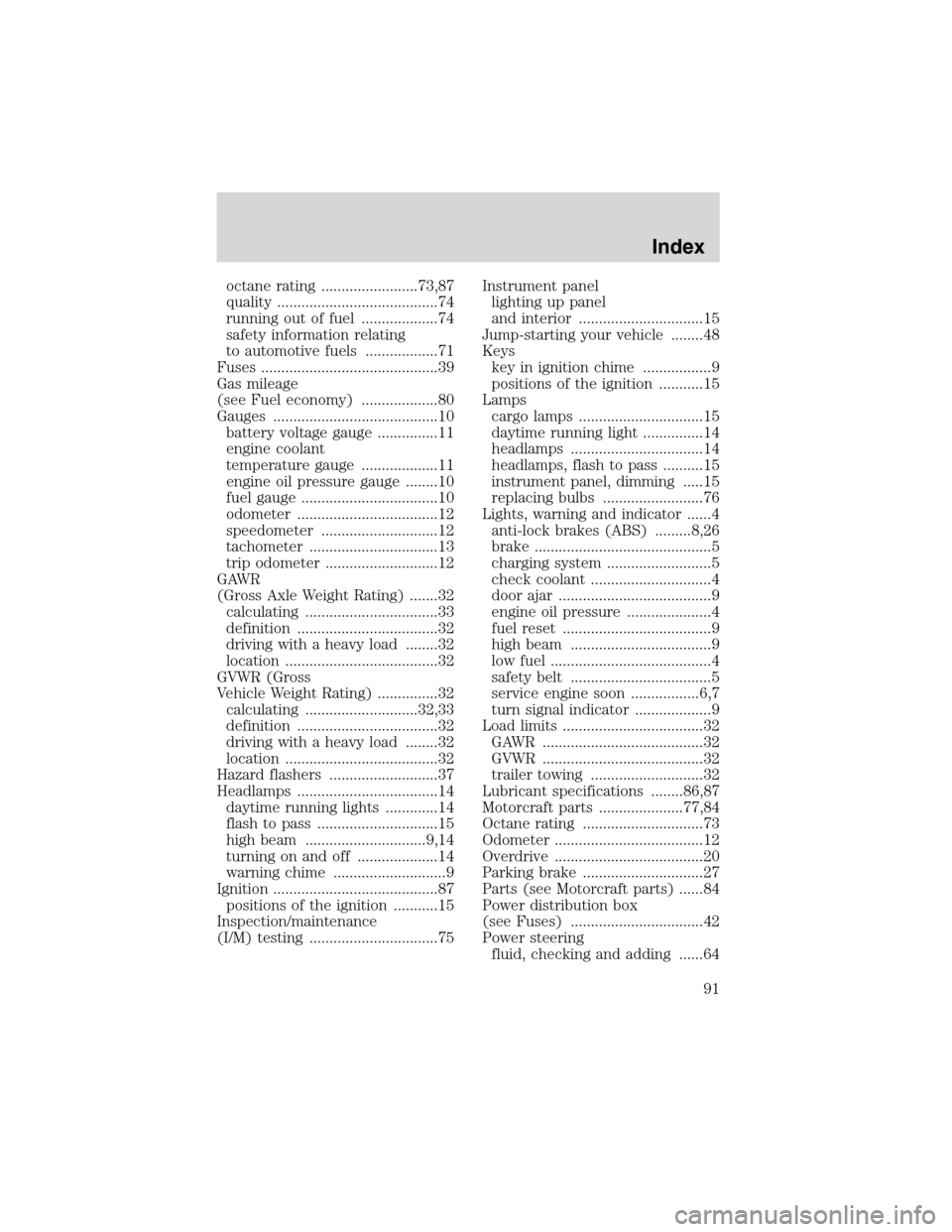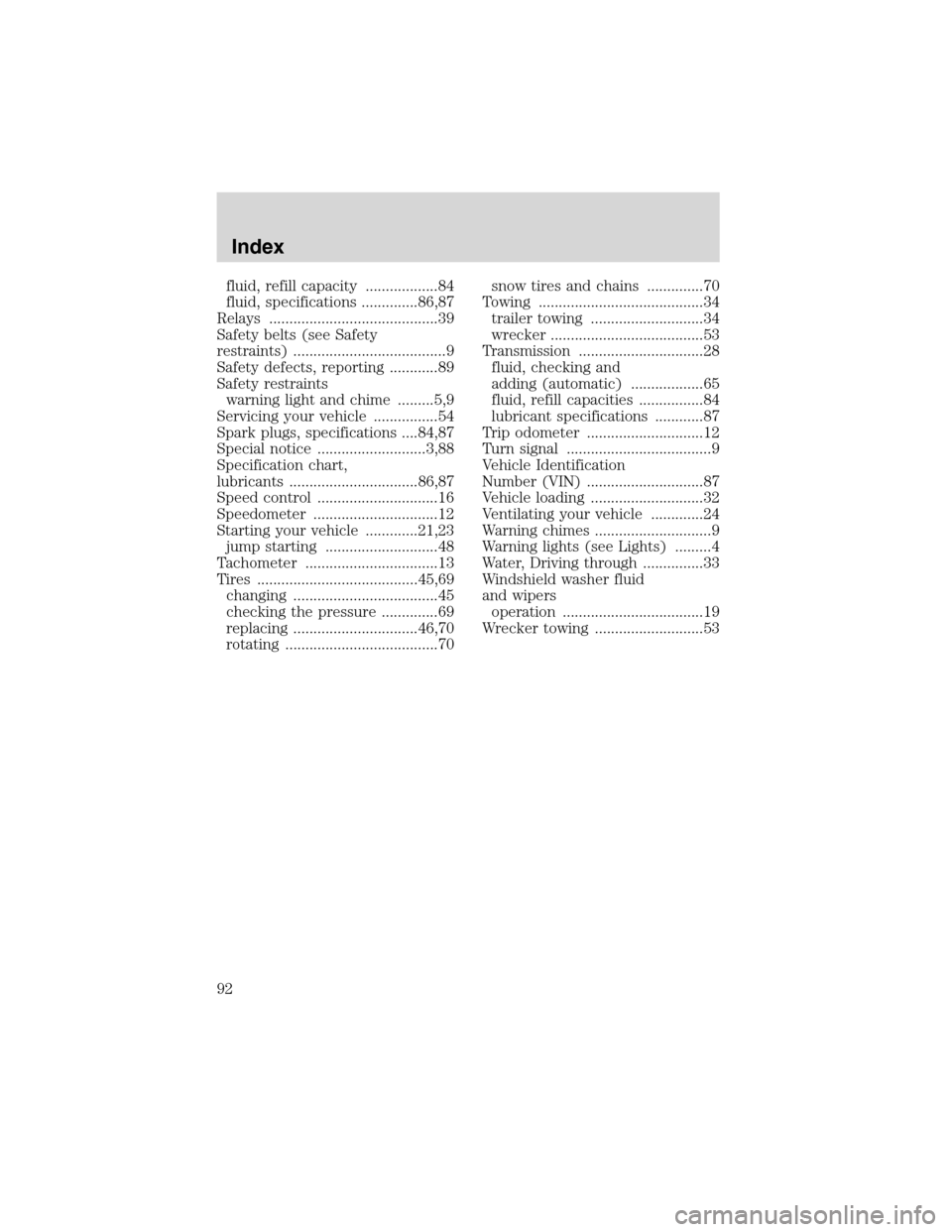trailer FORD F SERIES MOTORHOME AND COMMERCIAL CHASSIS 1999 10.G User Guide
[x] Cancel search | Manufacturer: FORD, Model Year: 1999, Model line: F SERIES MOTORHOME AND COMMERCIAL CHASSIS, Model: FORD F SERIES MOTORHOME AND COMMERCIAL CHASSIS 1999 10.GPages: 96, PDF Size: 0.57 MB
Page 65 of 96

TRANSMISSION FLUID
Checking automatic transmission fluid
Refer to your Scheduled Maintenance Guide for scheduled intervals for
fluid checks and changes. Your transmission does not consume fluid.
However, the fluid level should be checked if the transmission is not
working properly, i.e., if the transmission slips or shifts slowly or if you
notice some sign of fluid leakage.
Automatic transmission fluid expands when warmed. To obtain an
accurate fluid check, drive the vehicle until it is at normal operating
temperature (approximately 30 km [20 miles]). If your vehicle has been
operated for an extended period at high speeds, in city traffic during hot
weather or pulling a trailer, the vehicle should be turned off for about
30 minutes to allow fluid to cool before checking.
1. Drive the vehicle 30 km (20 miles) or until it reaches normal operating
temperature.
2. Park the vehicle on a level surface and engage the parking brake.
3. With the parking brake engaged and your foot on the brake pedal,
start the engine and move the gearshift lever through all of the gear
ranges. Allow sufficient time for each gear to engage.
4. Latch the gearshift lever in P (Park) and leave the engine running.
5. Remove the dipstick, wiping it clean with a clean, dry lint free rag.
6. Install the dipstick making sure it is fully seated in the filler tube.
7. Remove the dipstick and inspect the fluid level. The fluid should be in
the designated area for normal operating temperature or ambient
temperature.
Low fluid level
Do not drive the vehicle if the fluid
level is at the bottom of the dipstick
and the ambient temperature is
above 10°C (50°F).
Correct fluid level
The transmission fluid should be checked at normal operating
temperature 66°C-77°C (150°F-170°F) on a level surface. The normal
operating temperature can be reached after approximately 30 km
(20 miles) of driving.
Maintenance and care
65
Page 82 of 96

•Using the air conditioner or defroster may reduce fuel economy.
•Using speed control (if equipped) may improve fuel economy. Speed
control can help maintain a constant speed and reduce speed changes.
You may want to turn off the speed control in hilly terrain as
unnecessary shifting between third and fourth gears may occur and
could result in reduced fuel economy.
•Warming up a vehicle on cold mornings is not required and may
reduce fuel economy.
•Resting your foot on the brake pedal while driving may reduce fuel
economy.
•Combine errands and minimize stop-and-go driving.
Maintenance
•Keep tires properly inflated and use only recommended size.
•Operating a vehicle with the wheels out of alignment will reduce fuel
economy.
•Use recommended engine oil. Refer toLubricant Specifications.
•Perform all regularly scheduled maintenance items. Follow the
recommended maintenance schedule and owner maintenance checks
found in your vehicle Scheduled Maintenance Guide.
Conditions
•Heavily loading a vehicle or towing a trailer may reduce fuel economy
at any speed.
•Carrying unnecessary weight may reduce fuel economy (approximately
2 km/h [1 mpg] is lost for every 180 kg [400 lb] of weight carried).
•Adding certain accessories to your vehicle (for example bug
deflectors, rollover/light bars, running boards, ski/luggage racks) may
reduce fuel economy.
•Using fuel blended with alcohol may lower fuel economy.
•Fuel economy may decrease with lower temperatures during the first
12–16 km (8–10 miles) of driving.
•Driving on flat terrain offers improved fuel economy as compared to
driving on hilly terrain.
•Transmissions give their best fuel economy when operated in the top
cruise gear and with steady pressure on the gas pedal.
•Close windows for high speed driving.
Maintenance and care
82
Page 91 of 96

octane rating ........................73,87
quality ........................................74
running out of fuel ...................74
safety information relating
to automotive fuels ..................71
Fuses ............................................39
Gas mileage
(see Fuel economy) ...................80
Gauges .........................................10
battery voltage gauge ...............11
engine coolant
temperature gauge ...................11
engine oil pressure gauge ........10
fuel gauge ..................................10
odometer ...................................12
speedometer .............................12
tachometer ................................13
trip odometer ............................12
GAWR
(Gross Axle Weight Rating) .......32
calculating .................................33
definition ...................................32
driving with a heavy load ........32
location ......................................32
GVWR (Gross
Vehicle Weight Rating) ...............32
calculating ............................32,33
definition ...................................32
driving with a heavy load ........32
location ......................................32
Hazard flashers ...........................37
Headlamps ...................................14
daytime running lights .............14
flash to pass ..............................15
high beam ..............................9,14
turning on and off ....................14
warning chime ............................9
Ignition .........................................87
positions of the ignition ...........15
Inspection/maintenance
(I/M) testing ................................75Instrument panel
lighting up panel
and interior ...............................15
Jump-starting your vehicle ........48
Keys
key in ignition chime .................9
positions of the ignition ...........15
Lamps
cargo lamps ...............................15
daytime running light ...............14
headlamps .................................14
headlamps, flash to pass ..........15
instrument panel, dimming .....15
replacing bulbs .........................76
Lights, warning and indicator ......4
anti-lock brakes (ABS) .........8,26
brake ............................................5
charging system ..........................5
check coolant ..............................4
door ajar ......................................9
engine oil pressure .....................4
fuel reset .....................................9
high beam ...................................9
low fuel ........................................4
safety belt ...................................5
service engine soon .................6,7
turn signal indicator ...................9
Load limits ...................................32
GAWR ........................................32
GVWR ........................................32
trailer towing ............................32
Lubricant specifications ........86,87
Motorcraft parts .....................77,84
Octane rating ..............................73
Odometer .....................................12
Overdrive .....................................20
Parking brake ..............................27
Parts (see Motorcraft parts) ......84
Power distribution box
(see Fuses) .................................42
Power steering
fluid, checking and adding ......64
Index
91
Page 92 of 96

fluid, refill capacity ..................84
fluid, specifications ..............86,87
Relays ..........................................39
Safety belts (see Safety
restraints) ......................................9
Safety defects, reporting ............89
Safety restraints
warning light and chime .........5,9
Servicing your vehicle ................54
Spark plugs, specifications ....84,87
Special notice ...........................3,88
Specification chart,
lubricants ................................86,87
Speed control ..............................16
Speedometer ...............................12
Starting your vehicle .............21,23
jump starting ............................48
Tachometer .................................13
Tires ........................................45,69
changing ....................................45
checking the pressure ..............69
replacing ...............................46,70
rotating ......................................70snow tires and chains ..............70
Towing .........................................34
trailer towing ............................34
wrecker ......................................53
Transmission ...............................28
fluid, checking and
adding (automatic) ..................65
fluid, refill capacities ................84
lubricant specifications ............87
Trip odometer .............................12
Turn signal ....................................9
Vehicle Identification
Number (VIN) .............................87
Vehicle loading ............................32
Ventilating your vehicle .............24
Warning chimes .............................9
Warning lights (see Lights) .........4
Water, Driving through ...............33
Windshield washer fluid
and wipers
operation ...................................19
Wrecker towing ...........................53
Index
92